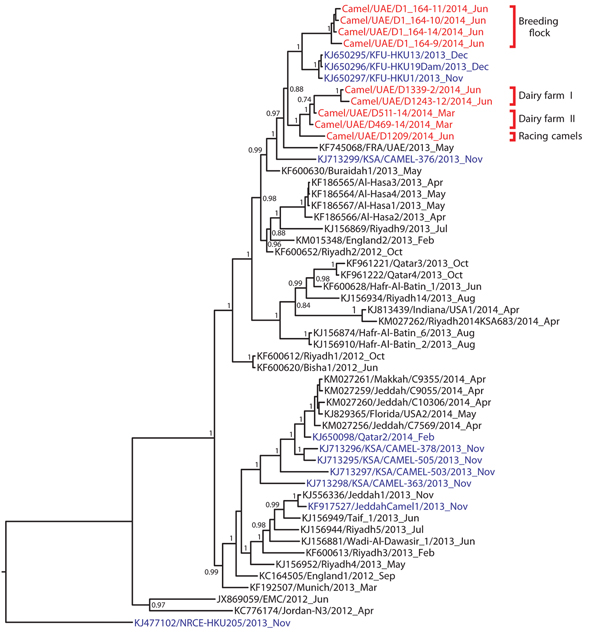Acute Middle East Respiratory Syndrome Coronavirus Infection in Livestock Dromedaries, Dubai, 2014
Sung Sup Park, Ulrich Wernery

, Victor M. Corman, Emily Y.M. Wong, Alan K.L. Tsang, Doreen Muth, Susanna K. P. Lau, Kamal Khazanehdari, Florian Zirkel, Mansoor Ali, Peter Nagy, Jutka Juhasz, Renate Wernery, Sunitha Joseph, Ginu Syriac, Shyna K. Elizabeth, Nissy Annie Georgy Patteril, Patrick C. Y. Woo, and Christian Drosten
Author affiliations: Central Veterinary Research Laboratory, Dubai, United Arab Emirates (U. Wernery, K. Khazanehdari, R. Wernery, S. Joseph, G. Syriac, S.K. Elizabeth, N.A. Georgy Patteril); University of Bonn Medical Centre, Bonn, Germany (V.M. Corman, F. Zirkel, C. Drosten); German Centre for Infection Research, Bonn (V.M. Corman, F. Zirkel, C. Drosten); University of Hong Kong, China (E.Y.M. Wong, A.K.L. Tsang, D. Muth, S.K.P. Lau, P.C.Y. Woo); Dubai Camel Hospital, Dubai (M. Ali); Emirates Industry for Camel Milk and Products, Dubai (P. Nagy, J. Juhasz)
Main Article
Figure

Figure. Phylogenetic analyses of the complete concatenated coding sequences of available Middle East respiratory syndrome coronavirus (MERS-CoV) genomes were done by using MrBayes v3.1 (http://mrbayes.sourceforge.net/) and a general time-reversible plus gamma distribution plus invariable site nucleotide substitution model with 2,000,000 generations sampled every 100 steps. Trees were annotated by using the last 75% of all generated trees in TreeAnnotator v.1.5 (http://beast.bio.ed.ac.uk/TreeAnnotator/) and visualized with FigTree v.1.4 (http://tree.bio.ed.ac.uk/software/figtree/). Statistical support of grouping based on Bayesian posterior probabilities is shown at all nodes (95% highest posterior density; shown if value >0.7). Red indicates the 9 camel MERS-CoV strains characterized in this study; blue indicates MERS-CoV sequences obtained from other camels. EMC, Erasmus Medical Centre; FRA, France; HKU, Hong Kong University; KFU, King Faisal University; KSA, Kingdom of Saudi Arabia; UAE, United Arab Emirates; USA, United States of America.
Main Article
Page created: May 15, 2015
Page updated: May 15, 2015
Page reviewed: May 15, 2015
The conclusions, findings, and opinions expressed by authors contributing to this journal do not necessarily reflect the official position of the U.S. Department of Health and Human Services, the Public Health Service, the Centers for Disease Control and Prevention, or the authors' affiliated institutions. Use of trade names is for identification only and does not imply endorsement by any of the groups named above.
